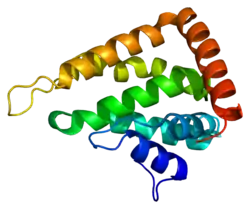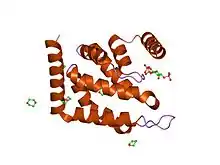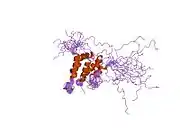EPN1
Epsin-1 is a protein that in humans is encoded by the EPN1 gene.[5][6][7]
EPN1 is an endocytic accessory protein that interacts with EPS15 (MIM 600051), the alpha subunit of the clathrin adaptor AP2 (AP2A1; MIM 601026), and clathrin (see MIM 118960), as well as with other accessory proteins for the endocytosis of clathrin-coated vesicles.[supplied by OMIM][7]
References
- GRCh38: Ensembl release 89: ENSG00000063245 - Ensembl, May 2017
- GRCm38: Ensembl release 89: ENSMUSG00000035203 - Ensembl, May 2017
- "Human PubMed Reference:". National Center for Biotechnology Information, U.S. National Library of Medicine.
- "Mouse PubMed Reference:". National Center for Biotechnology Information, U.S. National Library of Medicine.
- Chen H, Fre S, Slepnev VI, Capua MR, Takei K, Butler MH, Di Fiore PP, De Camilli P (Sep 1998). "Epsin is an EH-domain-binding protein implicated in clathrin-mediated endocytosis". Nature. 394 (6695): 793–7. doi:10.1038/29555. PMID 9723620. S2CID 4430975.
- Morinaka K, Koyama S, Nakashima S, Hinoi T, Okawa K, Iwamatsu A, Kikuchi A (Dec 1999). "Epsin binds to the EH domain of POB1 and regulates receptor-mediated endocytosis". Oncogene. 18 (43): 5915–22. doi:10.1038/sj.onc.1202974. PMID 10557078.
- "Entrez Gene: EPN1 epsin 1".
Further reading
- Drake MT, Downs MA, Traub LM (2000). "Epsin binds to clathrin by associating directly with the clathrin-terminal domain. Evidence for cooperative binding through two discrete sites" (PDF). J. Biol. Chem. 275 (9): 6479–89. doi:10.1074/jbc.275.9.6479. PMID 10692452. S2CID 22584410.
- Kariya K, Koyama S, Nakashima S, et al. (2000). "Regulation of complex formation of POB1/epsin/adaptor protein complex 2 by mitotic phosphorylation". J. Biol. Chem. 275 (24): 18399–406. doi:10.1074/jbc.M000521200. PMID 10764745.
- Hyman J, Chen H, Di Fiore PP, et al. (2000). "Epsin 1 Undergoes Nucleocytosolic Shuttling and Its Eps15 Interactor Nh2-Terminal Homology (Enth) Domain, Structurally Similar to Armadillo and Heat Repeats, Interacts with the Transcription Factor Promyelocytic Leukemia Zn2+ Finger Protein (Plzf)". J. Cell Biol. 149 (3): 537–46. doi:10.1083/jcb.149.3.537. PMC 2174850. PMID 10791968.
- Drake MT, Traub LM (2001). "Interaction of two structurally distinct sequence types with the clathrin terminal domain beta-propeller". J. Biol. Chem. 276 (31): 28700–9. doi:10.1074/jbc.M104226200. PMID 11382783.
- Ford MG, Mills IG, Peter BJ, et al. (2002). "Curvature of clathrin-coated pits driven by epsin". Nature. 419 (6905): 361–6. doi:10.1038/nature01020. PMID 12353027. S2CID 4372368.
- Strausberg RL, Feingold EA, Grouse LH, et al. (2003). "Generation and initial analysis of more than 15,000 full-length human and mouse cDNA sequences". Proc. Natl. Acad. Sci. U.S.A. 99 (26): 16899–903. doi:10.1073/pnas.242603899. PMC 139241. PMID 12477932.
- Koshiba S, Kigawa T, Kikuchi A, Yokoyama S (2003). "Solution structure of the epsin N-terminal homology (ENTH) domain of human epsin". J. Struct. Funct. Genomics. 2 (1): 1–8. doi:10.1023/A:1011397007366. PMID 12836669. S2CID 13317798.
- Ota T, Suzuki Y, Nishikawa T, et al. (2004). "Complete sequencing and characterization of 21,243 full-length human cDNAs". Nat. Genet. 36 (1): 40–5. doi:10.1038/ng1285. PMID 14702039.
- Gerhard DS, Wagner L, Feingold EA, et al. (2004). "The Status, Quality, and Expansion of the NIH Full-Length cDNA Project: The Mammalian Gene Collection (MGC)". Genome Res. 14 (10B): 2121–7. doi:10.1101/gr.2596504. PMC 528928. PMID 15489334.
- Timsit YE, Miller SL, Mohney RP, O'Bryan JP (2005). "The U-box ligase carboxyl-terminus of Hsc 70-interacting protein ubiquitylates Epsin". Biochem. Biophys. Res. Commun. 328 (2): 550–9. doi:10.1016/j.bbrc.2005.01.022. PMID 15694383.
- Schmid EM, Ford MG, Burtey A, et al. (2007). "Role of the AP2 β-Appendage Hub in Recruiting Partners for Clathrin-Coated Vesicle Assembly". PLOS Biol. 4 (9): e262. doi:10.1371/journal.pbio.0040262. PMC 1540706. PMID 16903783.
- Olsen JV, Blagoev B, Gnad F, et al. (2006). "Global, in vivo, and site-specific phosphorylation dynamics in signaling networks". Cell. 127 (3): 635–48. doi:10.1016/j.cell.2006.09.026. PMID 17081983. S2CID 7827573.
This article is issued from Wikipedia. The text is licensed under Creative Commons - Attribution - Sharealike. Additional terms may apply for the media files.








